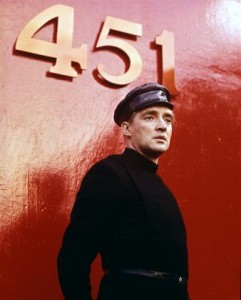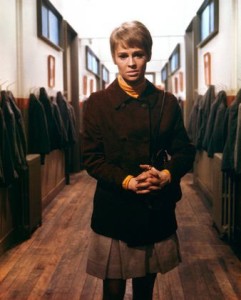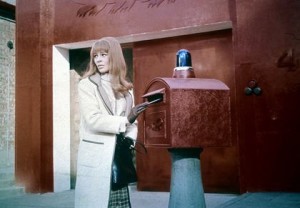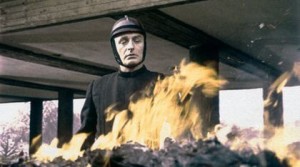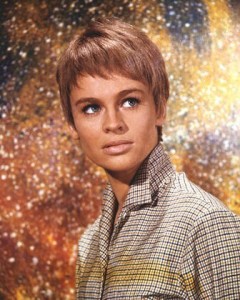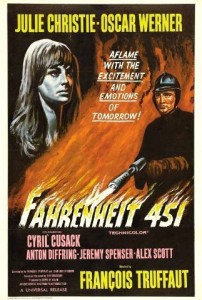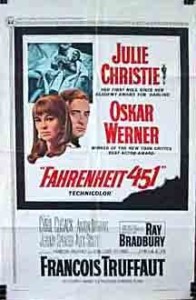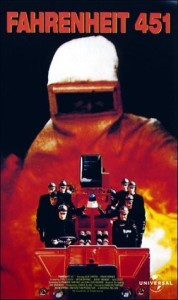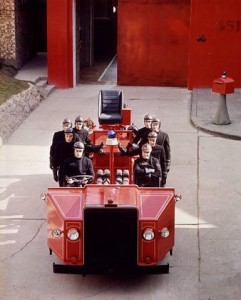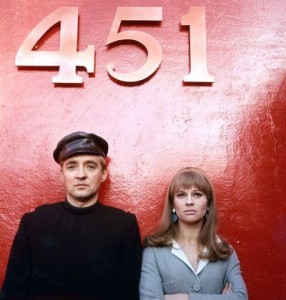Fahrenheit 451 **** (1966, Julie Christie, Oskar Werner, Cyril Cusack, Anton Diffring, Jeremy Spenser, Bee Duffell, Michael Balfour, Ann Bell) – Classic Movie Review 3012
François Truffaut’s love of books shines through his thoroughly compelling and intriguing adaptation from Ray Bradbury’s 1953 novel of his 1984-style sci-fi story about a typically oppressive, dystopian future world where books have been outlawed by a government fearing an independent-thinking society and firefighters go around burning works of literature. It is Truffaut’s first colour film and only non French-language film as director.
Julie Christie and Oskar Werner are both warm star presences as the book lover Clarisse and the fireman book burner Guy Montag, whom she converts to her way of thinking. Montag falls in love with the book-hoarding Clarisse and begins to read confiscated books, prompting him to begin to question the government’s motives behind book-burning. Less happily, Christie is cast in a double role and also plays Werner’s wife Linda.
People in their lonely, isolated society, including Montag’s wife, are drugged into compliance and get their information from wall-size TV screens. Thus brainwashed, they act as informants on people who read books.
There is no doubt that Truffaut’s 1966 film Fahrenheit 451 is superb technically. The gleaming bright poster colours look great in Nicolas Roeg’s glorious Technicolor cinematography and there is a notable Bernard Herrmann score too. The stylish costumes and production design are by Tony Walton and Syd Cain is the inventive art director.
But, though the story holds firm, thanks to well-written individual scenes, there is something a bit shaky and hesitant about the film’s tone and pacing that is unique in Truffaut’s work. So that is probably connected with his difficulty in speaking English when making a film with British actors in the UK.
Truffaut spoke virtually no English, so the production work was done in French, writing the screenplay with Jean-Louis Richard. Truffaut disliked the film’s often stilted and unnatural-sounding English-language dialogue and was much happier with the version dubbed into French. There is uncredited additional dialogue by David Rudkin and Helen Scott.
The film is topped off with a marvellous final image of a community learning aloud by heart three great works of fiction. This optimistic idea of the extended family of the literary commune at the end of the movie poses a fascinating premise that provides a 60s-style antidote to Truffaut’s normally pessimistic view of traditional relationships in his films. Like the books in the film, the opening credits are also narrated. Nobody is reading in an illiterate culture.
Playing the man with the apple, former child star Jeremy Spenser appears in his last film, aged 29; after this he vanished without trace but is confirmed to be still alive and well.
Jeremy Spenser (born Jeremy John Dornhurst de Saram 16 July 1937) made his screen debut aged 11 in Anna Karenina (1948) and appeared in Kind Hearts and Coronets, The Prince and the Showgirl and Ferry to Hong Kong.
Also in the cast are Cyril Cusack as The Captain, Anton Diffring as Fabian/ Headmistress, Bee Duffell as Book woman, Michael Balfour, Ann Bell, Caroline Hunt, Gillian Lewis as Cousin Midge on TV, Anna Palk, the future Oliver! little star Mark Lester, Alex Scott and Dennis Gilmore.
Bradbury said that he wrote Fahrenheit 451 because of his concerns about the threat of book burning in the US during the McCarthy era. The book’s title page explains: ‘Fahrenheit 451 – The temperature at which book paper catches fire and burns.’ Bradbury was told that 451 deg Fahrenheit was the auto-ignition temperature of paper. Studies have put the auto-ignition temperature between 424 and 475 deg Fahrenheit depending on the type of paper.
Truffaut’s diary called Fahrenheit 451 his ‘saddest and most difficult’ film-making experience, mainly because of the intense conflicts he had with Werner.
Fahrenheit 451 was shot at Pinewood Studios, England. The monorail is filmed at the French SAFEGE test track in Châteauneuf-sur-Loire near Orléans), and the Alton housing estate in Roehampton, south west London, and Edgcumbe Park in Crowthorne, Berkshire, are featured. The final scene of the Book People reciting their chosen books was filmed at Black Park, near Pinewood, in a snowstorm on Julie Christie’s birthday, 14 April 1966.
Christie was originally cast as just Linda Montag, but the producer Lewis M Allen had the idea of her playing Clarisse too, as two sides of the same coin. Unfortunately, this idea works only up to a point. If they had got Jean Seberg, Jane Fonda or Tippi Hedren to play Clarisse, as planned, this would be a better movie.
Truffaut also asked Helen Scott to assist him during his interviews with Alfred Hitchcock and she established the US version of the book Hitchcock/Truffaut.
Hitchcock told Truffaut that Hedren was not available.
Truffaut told Jean Luc Godard: ‘You mustn’t think that Alphaville (1966) will do any harm whatsoever to Fahrenheit 451’ – but it turned out he was wrong.
Bradbury said that he was pleased with the film, despite its flaws and was particularly fond of the snowy climax. However, he said: ‘The mistake they made was to cast Julie Christie as both the revolutionary and the bored wife.’
It is remade as Fahrenheit 451 (2018), directed and co-written by Ramin Bahrani, and starring Michael B Jordan, Michael Shannon, Sofia Boutella, Lilly Singh, Grace Lynn Kung and Martin Donovan.
© Derek Winnert 2015 Classic Movie Review 3012
Check out more reviews on http://derekwinnert.com

